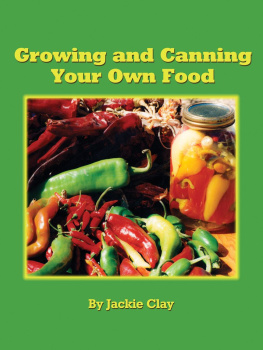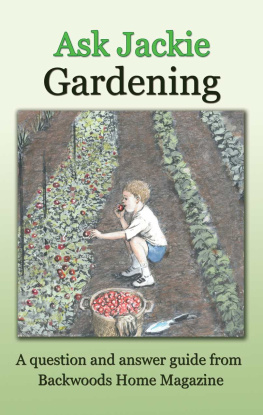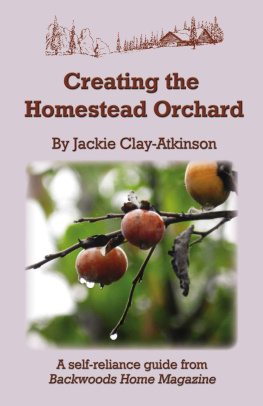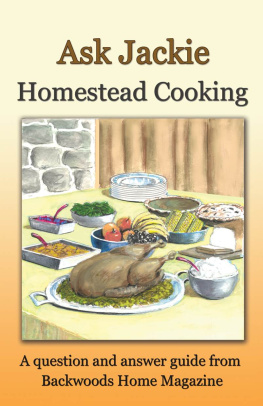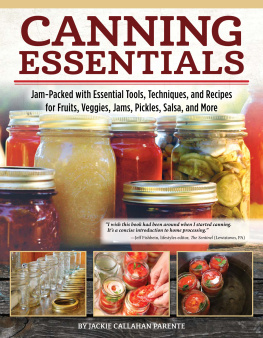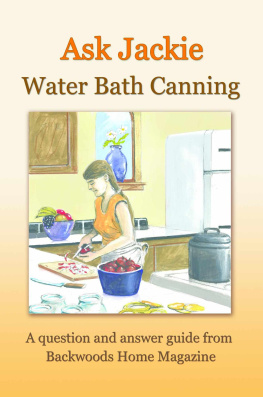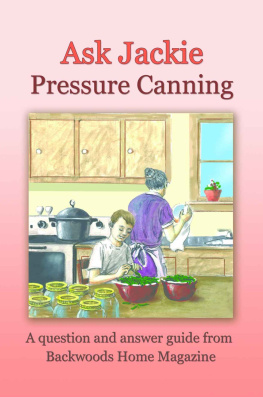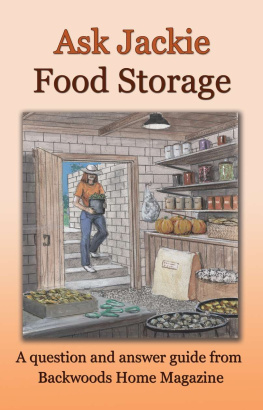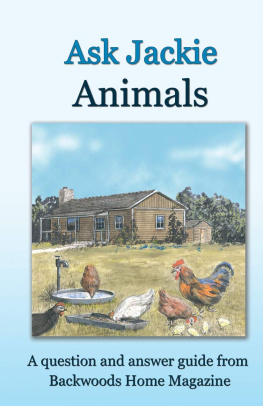Jackie Clay-Atkinson - Growing and Canning Your Own Food
Here you can read online Jackie Clay-Atkinson - Growing and Canning Your Own Food full text of the book (entire story) in english for free. Download pdf and epub, get meaning, cover and reviews about this ebook. year: 2012, publisher: Backwoods Home Magazine, genre: Children. Description of the work, (preface) as well as reviews are available. Best literature library LitArk.com created for fans of good reading and offers a wide selection of genres:
Romance novel
Science fiction
Adventure
Detective
Science
History
Home and family
Prose
Art
Politics
Computer
Non-fiction
Religion
Business
Children
Humor
Choose a favorite category and find really read worthwhile books. Enjoy immersion in the world of imagination, feel the emotions of the characters or learn something new for yourself, make an fascinating discovery.
- Book:Growing and Canning Your Own Food
- Author:
- Publisher:Backwoods Home Magazine
- Genre:
- Year:2012
- Rating:5 / 5
- Favourites:Add to favourites
- Your mark:
- 100
- 1
- 2
- 3
- 4
- 5
Growing and Canning Your Own Food: summary, description and annotation
We offer to read an annotation, description, summary or preface (depends on what the author of the book "Growing and Canning Your Own Food" wrote himself). If you haven't found the necessary information about the book — write in the comments, we will try to find it.
Jackie Clay-Atkinson: author's other books
Who wrote Growing and Canning Your Own Food? Find out the surname, the name of the author of the book and a list of all author's works by series.
Growing and Canning Your Own Food — read online for free the complete book (whole text) full work
Below is the text of the book, divided by pages. System saving the place of the last page read, allows you to conveniently read the book "Growing and Canning Your Own Food" online for free, without having to search again every time where you left off. Put a bookmark, and you can go to the page where you finished reading at any time.
Font size:
Interval:
Bookmark:
Table of Contents

ISBN 978-0-9821577-5-6
Copyright 2009, 2012
Backwoods Home Magazine
PO Box 712
Gold Beach, Oregon 97444
www.backwoodshome.com
Edited by Annie Tuttle, Rhoda Denning, and Ilene Duffy
Introduction
G rowing and canning your own food is probably the most practical skill a self-reliant minded person can learn. Not only will it favorably impact your pocketbook, but it will dramatically improve your mental outlook on life. Being able to provide home-grown, pesticide-free, outrageously healthy fruits, vegetables, and meats for your family is an uplifting and enlightening experience. If youre weary of the rising cost of foods at the grocery store, or are unsure about feeding your family food that is laden with chemicals, dyes, hormones, excessive salts, hard fats, and an occasional rodent hair from the factory floor, youve got the right book in your hands.
Not only can a person easily grow much of their familys food, but they can also home can it so it will fill up a pantry with jewel-like jars, packed full of nutritious, chemical-free food that actually tastes like Grandmas homegrown goodness. As the seasons pass, the pantry will become more and more well stocked, giving a great feeling of self-reliance. Once your food is properly canned, it remains perfectly good for years. No matter what hard times should befall you, be it a power outage, job loss, ice storm, or nationwide economic upheaval, you and your family will still eat well from the fruits of your labor.

Growing and canning your own food gives you a feeling of self-reliance and packs your pantry shelves with jewel-like jars filled with nutritious, chemical-free, outrageously tasty food.
Unlike your freezer, your home canned food is safe from power outages. Freezing food is quick and easy, but if the freezer malfunctions or the power goes out for any length of time, the food in it will thaw and become an unpalatable mess. This is why I sold my freezer and started canning all of my food: fruits, vegetables, poultry, fish, and meats, too. Once in the jar, my food is good for years and years. No matter what.
Neither gardening nor canning is expensive, hard to learn, or physically demanding. My young children loved helping in the garden, and as they grew older, they were a true help. My 92-year-old mother, who is wheelchair bound, still gardens in raised containers.
Sometimes its best to start with a modest-sized garden and work up as your experience grows. A big garden, all at once, can become overwhelming when youre new to the game. The same goes for canning. Its best to start home canning by learning to process tomatoes and tomato products like sauces, salsas, and barbecue sauce, then move on to jams and jellies. All these are high acid foods that can be safely canned using a boiling water bath canner. This is simply a large pot of boiling water. Even new, a boiling water bath canner is quite inexpensive, and the other tools you need are cheaper yet.
You can often find jars at yard sales, thrift stores, and auctions. If you pass the word around that youre looking for canning jars, soon youll be the recipient of boxes and boxes of them, usually free for the taking. You need to buy new jar lids each time you can, but the rings that tighten them down for processing can be used year after year, as long as they remain free of rust and are in good shape. You can remove the rings after each batch of jars cools down after processing. The rings do nothing to help the jars remain sealed, they only hold the lid firmly in place during processing.
I can food year-round, making chili, stew, dry beans, (like pintos for refried beans), spaghetti sauce, pizza sauce, smoked trout, elk stew, etc. Whatever the season, theres always something special to can for later meals.
Nearly anything you can find on a store shelf can be canned easily at home. When I tell this to people, Im usually met with the same blank stare and the questions: Isnt home canning hard to do? Wont eating home-canned food give you food poisoning? Wont the canner blow up?
No. Canning is very easy. If you can boil water and tell time you can home can. Properly canned food will not give your family food poisoning. Ive been canning for 40 years and no one has ever suffered any ill effects from my delicious home-canned food. The canner will not blow up, despite old cartoons to the contrary. My old canner is 30 years old, has received very heavy use, and is still going strong.
It is simple to start out. Canning doesnt even require a pressure canner, which can cost about $89-$150 new. (Remember, though, that this is often a once-in-a-lifetime expense, bringing the cost down to only a few dollars a year. A person may begin canning with a boiling water bath canner, available at most discount stores for under $20. These are the big blue pots with a lid and wire rack you may already be familiar with. You can also find them at yard sales. Just hold them up to the light and stick your head inside to be sure there are no small holes that would allow leakage.
Do you want to give it a try? I promise its very worthwhile, and once youre hooked, youll find yourself immersed in a great way of life that will nourish your body and soothe your soul. Growing and canning your own food is a road to independence.
Gardening basics
C hoose a site for your garden that receives at least half a days worth of spring and summer sun, out of the shade of buildings, rock formations, or trees. Full sun is better, except in very hot climates.
Youll want your garden in a spot that is relatively near your house so that tending it wont become a chore and you can easily wander out at spare moments to enjoy your beautiful plants or pull a few weeds.
If you live in an area with a short growing season (the time between the last spring frosts and the first fall frosts), choose the highest available site for your garden. Cold and frost, like water, flow to lowest spots first. A garden twenty feet lower, in a valley, will freeze more often than one up on a sunny knoll.
If you have a choice, pick a spot that has decent garden soil. A near perfect soil is black sandy loam. It is naturally fertile, deep, and has good drainage. If no such spot exists in a convenient location, dont despair; you can improve poor soil.
Plan on fencing your garden with 6-foot high welded 2x4-inch wire. This will keep out dogs and cats, chickens, a stray goat or cow, deer, elk, moose, and most bears, not to mention playing neighbor children, who are even more dangerous to your garden. There are various animal repellents on the market, but Ive tried em all, and they just dont work dependably. Besides, they are just too expensive over the long term. If you cant afford to fence your entire garden at once, do one side at a time and do what you can to keep your garden safe until you can get it completely enclosed.
If youre starting with a small garden, remove your sod or kill the grass and weeds. You can do this by watering the area well on a sunny week, then placing black plastic over the entire area and weighting it down with rocks so it remains in place. By leaving it there for five or six weeks, youll effectively kill grass, weeds, and even their seeds which lie ready to germinate as soon as you work the soil up. This process is called solar sterilization or cooking the soil.
If your soil is heavy clay or sandy gravel, youll want to work in lots of organic material. Old, rotted, straw-filled manure is perfect. You can hardly use too much. Be sure it is old and rotted, because fresh manure contains too much nitrogen which will cause forked, misshapen carrots, scabby potatoes, and rampant tomato vines with few tomatoes. (The next year, as the manure rots down, these problem will be resolved, but youll lose a productive year if you use fresh manure.) Other organic material, such as fall leaves, pine needles, straw, and seed and weed free hay (be sure it has no seeds or youll have a hay field, not a garden) will also quickly improve your garden soil. On a newer garden, I add organic material every spring and fall, and I mulch all summer with it, as well. It wont take long before that crummy soil is fertile and extremely productive.
Next pageFont size:
Interval:
Bookmark:
Similar books «Growing and Canning Your Own Food»
Look at similar books to Growing and Canning Your Own Food. We have selected literature similar in name and meaning in the hope of providing readers with more options to find new, interesting, not yet read works.
Discussion, reviews of the book Growing and Canning Your Own Food and just readers' own opinions. Leave your comments, write what you think about the work, its meaning or the main characters. Specify what exactly you liked and what you didn't like, and why you think so.

